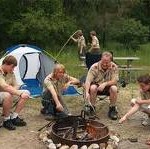 Arrive at your destination with time and energy to set up a good camp. If your intended destination is full, you can use the extra daylight to move on and find another location for the night. If you’re in an area that receives a large amount of use, chances are good that you’ll find another established site nearby. Spend some time scouting around to find an appropriately located one. With care, further use of these sites will cause very little additional impact.
Arrive at your destination with time and energy to set up a good camp. If your intended destination is full, you can use the extra daylight to move on and find another location for the night. If you’re in an area that receives a large amount of use, chances are good that you’ll find another established site nearby. Spend some time scouting around to find an appropriately located one. With care, further use of these sites will cause very little additional impact.
Choose a campsite that is somewhat elevated or that has a slight slope so water will not pool if it rains. This makes it unnecessary to trench around tents, which disturbs soils and gives the site an unnatural look. Never scrape away or “clean” sites of leaves and other organic litter-they help to cushion trampling forces, and reduce the erosive action of rainfall and water runoff.
Choose a site big enough for your group to avoid enlarging the hardened area or developing adjacent “satellite” use areas. Tents, traffic routes and kitchen areas should be con fined to existing hardened areas or naturally resistant surfaces. If the site you’ve found is not large enough to accommodate your tent without removing or damaging vegetation, move on and find another site.
Leave your site clean to increase the likelihood that other visitors will use it. Food and idle equipment should be put away securely so it will not be scattered by a sudden wind or damaged by a marauding mouse or chipmunk. In areas where scavenging animals are a problem, especially bears and raccoons, safeguard your food by hanging it, as described later in this booklet. An otherwise adequate site, littered with trash and food encourages the spread of impact to pristine spots, and will not appeal to anyone except scavenging animals.




Leave a Comment